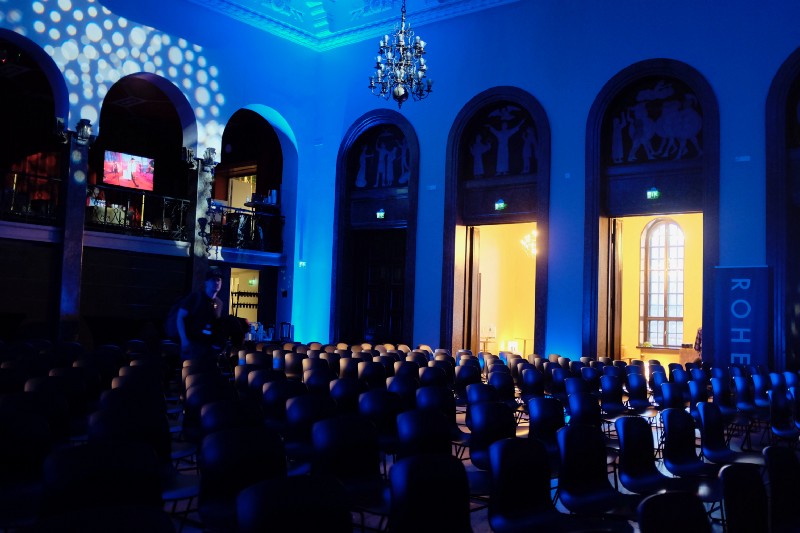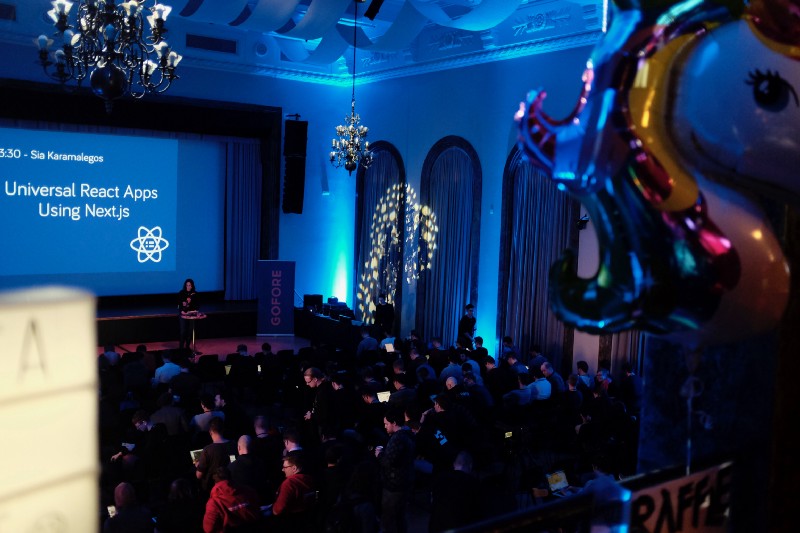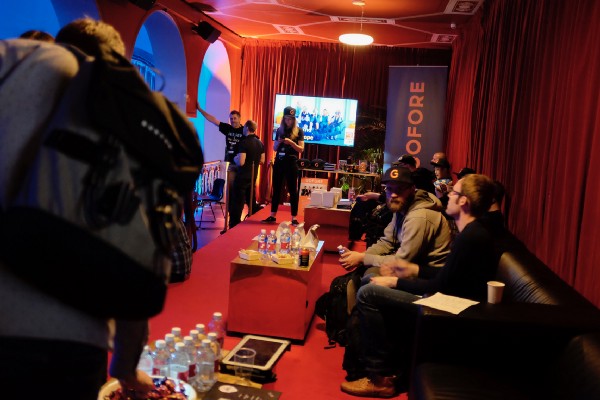 React Finland
React Finland
React Finland 2018 — Lessons Learned
React Finland 2018 is a wrap. It was the first time that we organized a conference. Although we were well prepared, there are always those unknown unknowns you learn about only after you hit the conference days. Fortunately we were able to adapt and fix several issues during the conference itself. We are now even more prepared for the next edition of React Finland!
I had made some personal observations from a speaker perspective and had some idea of what a good conference might look like. Mostly we were fairly inexperienced and learned as we went.
In this post, I’ll reflect on what I feel worked and what didn’t. I believe each conference has a formula and I think we found one for React Finland. Despite rough edges it felt like a good event that can become a great one when certain issues are fixed.

It will be a great conference day.
Workshops#

We had Jaffa cookies, bananas, and other goodies for our workshop students.
The conference began with a day of workshops on topics related to React and web development. The workshops were held in two locations and most were half-day long except for Michel’s one on state management.
In retrospect, it would have been better to focus on full day workshops and have a single location instead of two. Having two places added complexity and made it trickier to manage.
Venue#

The venue was blue as Finland.
The venue, Valkoinen Sali, was a good pick for the first edition of React Finland. The space looks amazing and it was just about enough for our 300 attendees although there weren’t enough chairs in the beginning. We fixed the situation for the second day.
It was a good idea to have a dedicated space for the conference sponsors. The advantage of doing this is that then people can choose to go there and they have their private space where to discuss and pitch. In addition, the view from the balcony area was great and a good reason alone to visit the sponsors.

The balcony was reserved for our sponsors.
I think we’ll want to grow the conference by hundred people for the next year. This year we sold out far too early, two months before the conference. It’s a positive problem but I feel we should be able to sell more last minute tickets as it doesn’t feel good to leave interested people out.
Price-wise we can go up a notch although we should still remain in 400 euro range for the conference alone to keep it affordable for most developers and to communicate the value. Compared to other technical conferences in Finland, we are still on the cheap side even after this change.
Food#

A smoothie to start the first conference day.
At least from my perspective, we did mostly well with food and it was quite tasty. The main problems were that we didn’t have anything substantial for the afternoon break and the vegetarian main option wasn’t communicated clearly enough.
Schedule#

There was coffee. Finnish style.
This was the first time we scheduled a conference. Although we managed to stay on time and avoid serious technical issues, especially during the first day there was sometimes too much time between the presentations.
The main slots were designed to be 45 minutes long. If a presentation was 30 minutes in total with questions included, that meant you would 30 minutes to the next one since standard breaks were 15 minutes. In addition, we had two 30 minute afternoon breaks for the first day.
We managed to fix this mostly for the second day by improvising. Instead of having separate sessions for lightning talks, we used them to fill the gaps. If we knew a talk was going to be 30 minutes long, we put a lightning talk after it. This was possible because we had a couple prepared just in case.
We also squeezed the schedule for the second day by 30 minutes and dropped one longer break. It felt the second day flowed better as a result and we’ll keep it tight like this in the future to maintain momentum.
We could have communicated the change better through announcements and having notifications through our mobile app. Surprisingly many people were using it so it feels like a natural place to improve.

The mixing table was rather heavy duty.
Given it’s tricky to get a Finnish audience to ask questions, we should prepare a few beforehand to get it going. It’s better the host asks something first as then the audience might be more willing to follow.
On the second day we realized it’s a good idea to move the mic to the person asking the question. We might consider using the mobile app for questions next year instead to save a bit of time and make it easier to ask and moderate.
Mobile App#
Perhaps surprisingly, people found the conference app. In its current state is roughly a mirror of the conference site. There’s potential for further development as we can add notifications about schedule changes, enable gathering feedback and questions, make it easier to connect with other people to mention several development directions.
Although it’s debatable whether a conference should have an app or not, I think I see the value now. A good app can be much better than a site especially when you provide unique functionality not possible to develop on the web.
Presentations#

Christian Alfoni starting his presentation.
The presentations of the two day conference were varied and we did some experimentation with the program. The first day was more like what you might expect from a normal conference. The only major difference was two longer breaks late in the day.
The second day started from Ken Wheeler’s presentation about the future of React and flowed into two talks about ReasonML by Nik Graf and Patrick Stapfer. David Khourshid’s excellent talk on state machines continued on the path.
I believe pairing and connecting presentations like this should become an important part of the identity of React Finland. It seems having complementary presentations is a good idea as it allows you to see the concepts from different angles. Having both theory and practice helps to enforce the points.

Nik Graf showed us that there’s reason behind ReasonML.
Keynotes#

It’s Ken in his city look before heading to the stage.
We chose Jani Eväkallio and Ken Wheeler as our keynote speakers. I don’t regret this choice as they set the tone for each day. Ken’s talk even referred to Jani’s. The talks were more inspirational by nature and I feel that’s a good way to go with keynotes. They are supposed to give something to think about and this is something to retain in the next year’s edition of React Finland.
Sponsors#

Solita hearts React and we do too.
We had more demand for sponsoring than we had sponsor slots. Mersenne Twister solved the problem. Restricting the amount seemed to work as then the chosen sponsors receive better value for their investment.
We went with two gold sponsors (Gofore and Solita), three silver ones (Elisa, Motley, Nitor), and four bronze (Alma, Geniem, Rohea, Verkkokauppa.com) sponsors. One of the main points was to give the main sponsors their own space at the balcony of the venue. They added value to the conference and I feel it was the right call to accept sponsors for the event although it added tiny commercial taste to it but nothing wrong with that.
Volunteers#
We also received indirect support from Integrify and most of our volunteers came through them. Their goal is to help people, especially immigrants, to get employed in the tech sector. Doing this allowed us to give less privileged people access to our conference and make it more diverse.
We were amazingly lucky to find Mikhail Novikov to manage the volunteering efforts and I feel the volunteers did great work.
One thing to note is that we had too many volunteers. Instead of twenty, fifteen (about five per day) would have been enough but it’s better to have too many than too few.
Speakers#

Kasia Jastrzębska getting ready.
We had speakers from around the world. A few from the US, Israel, and plenty more around Europe. In retrospect, it may have been a good idea to have more local speakers.
All speakers including lightning speakers and workshop teachers were given a free ticket to the conference and also were invited to a speaker dinner. We believe this is how it suppose to be!
We also gave access to Allas Sea Pool and had informal program on the side. The access was also given to our attendees as we wanted to give them something extra.
Half of our workshop profit goes to the coaches organizing them. In monetary terms this is around 11000 euros. I feel it’s the least we can do given the effort it takes to come up with the material.
It would be nice to have a more organized trip for our speakers next year but you can’t do everything on the first year.
Afterparty#

It’s a big fish. We call it “mureena” in Finnish.
Our initial plan was to have two afterparties, one after each conference day. Due to budget constraints, we could afford only one after the second day. As a result we improvized on the first one and let interested companies provide multiple options.
People could choose between karaoke, sauna, and bar at least. On the second day the afterparty was held at Sea Life Helsinki.
In retrospect, having only one afterparty was the right way to go as two would have been too much. Now the first day had more variety while the second day had something more formal.
We expected more people to come to Sea Life and we had arranged buses to match conference capacity. As it happens, perhaps only half of people wanted to go there so we had more buses (and beer) than we would have needed. Next time we have to find a better way to figure this out.
The large amount of people expected led to another problem —lack of food. We tried to get a food truck at the afterparty location but they refused to sell since there were too many people to feed.
Although I was skeptical first, Sea Life aquarium seemed to work well for an afterparty as people could form groups around it and mingle. It wasn’t loud like a bar and you had a unique chance too see the fish up close without the normal crowd around you.
 for the photo.](/a925d52eac39e553a8187a6190498fe8.jpeg)
The conference had its own beer! Thanks to EsaMatti for the photo.
Allas Sea Pool#
Given one of the things that makes Finland the country it is, we arranged our attendees free access to Allas Sea Pool. It was around the corner from the venue and it seems people that went there enjoyed the experience. We should do something similar next year and surprise people somehow.
Conclusion#

The venue was right next to the main attractions of Helsinki.
I feel the first edition of React Finland was a success. People seemed to enjoy it and despite its rough edges, we did well overall. Now that we have some experience under the belt, we can improve in the next edition. Somehow React and Finnish awkwardness work together.
Give us feedback on React Finland 2018 so we know what to improve next year!